Establishing your budget is the first and often one of the most challenging steps in the design process, but you must set a budget to avoid unmet expectations and miscommunication. A budget communicates clearly with your designer about your expectations for furniture quality & design and what you’re willing to pay for both.
Budgeting can be a confusing step for homeowners and clients due to their uncertainty about what a reasonable price is to get their space “looking and feeling” the way they want it to. To help communicate with homeowners about what it can cost to decorate a room, we created this blog post. This post is chock-full of our best tips & tricks for budgeting for your next interior design project, along with a few ways that you can save money.
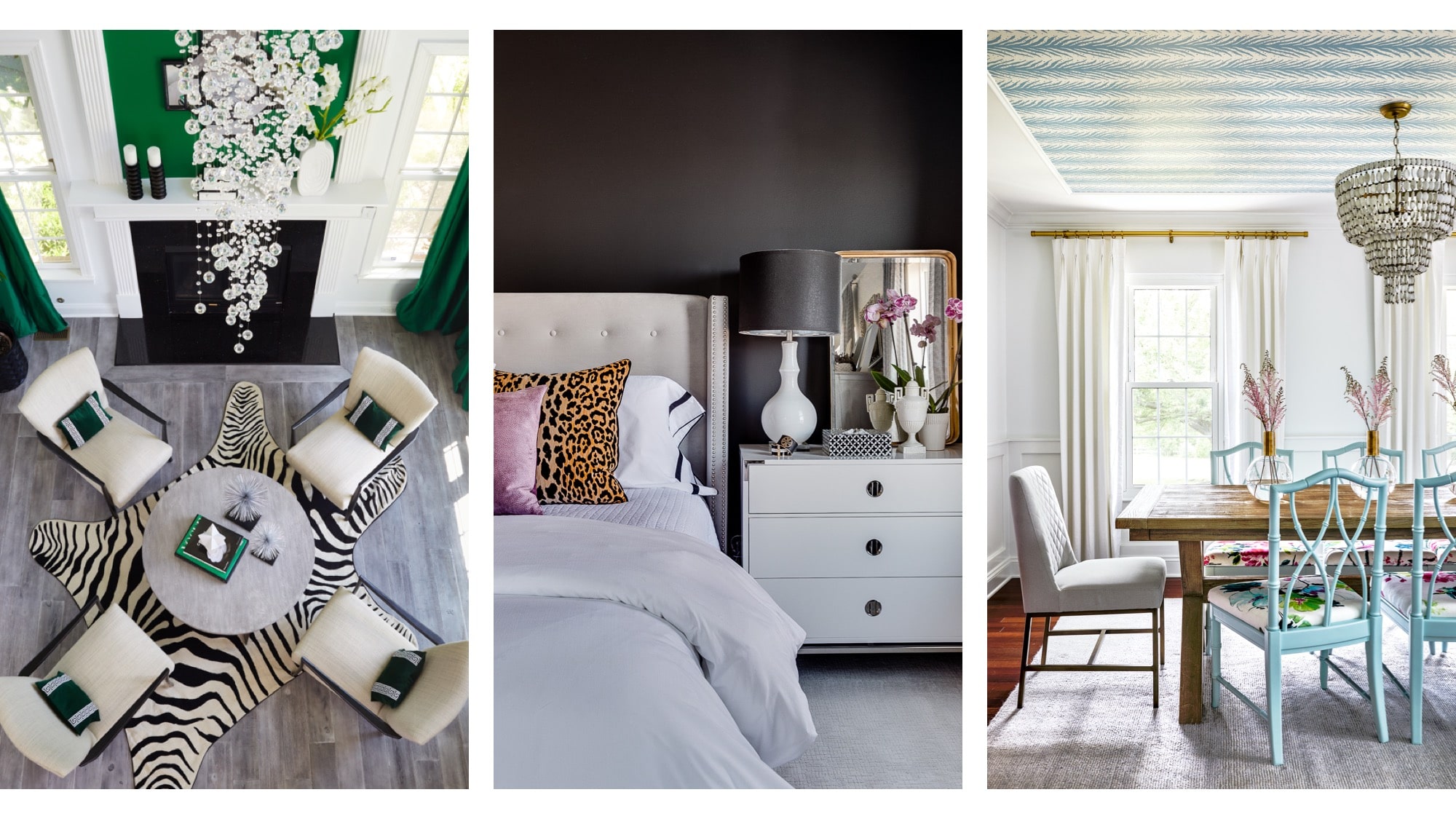
Design by GreyHunt Interiors, Photography by Stacy Zarin Goldberg and Christy Kosnic
A Good Rule Of Thumb
First, we want to start with some disclaimers (so that everyone is on the same page).
Every project is different, and so is every budget.
There’s no “one-size-fits-all” budget for designing a room. Budgets rely on critical information such as the size of the room, the quality & brands of furniture required, and the specific pieces/amount of furniture you’ll need to purchase. Budgets also don’t always fall into the two categories we’ve laid out below. Often, our clients select various pieces from each price category to create their customized budget. For example, a client may choose a trade brand sofa but decide to save money with retail-level chairs. Mixing & matching pieces in a design to meet your budget is one of the many things a professional interior designer does for you. **To help create your estimated budget, download our personalized budget worksheet here.
Budget with your home’s value in-mind.
What you should spend on a home renovation or just furnishings depends on the overall value of your home. As a general rule of thumb, we suggest allocating about 7-10% of the home's value for interior design expenses. This will give you a design with some "Mid-Range" products. If you're looking for "Designer" level finishes, we recommend budgeting about 25% of the home's overall value. For example, for a $2 Million home, we would suggest budgeting around $500,000+ to decorate & design the whole house at the "Designer" level. * It's important to note that these prices would not include home renovation expenses (construction costs, etc.) Feeling like that's a lot of money? We understand! Keep in mind that many clients have items that we can work with (ex. re-upholstering, re-finishing, or using pieces as-is) which can help save money & reduce expenses.) Don't worry - we will always keep your bottom line in mind and are constantly looking for the best available deals.
Plan to go over-budget:
I know this sounds counter-intuitive, but it’s not. With our years of experience, we’ve learned that people (on average) tend to go over their budget. This doesn’t mean that you won’t be able to stick to a budget. It just means that client’s often add features or upgrade finishes as the design process progresses—all of these additions, in turn, increase the scope and cost of the budget. To avoid unexpected overages (or disappointed expectations), we suggest that our clients add about 20% to their initial budget estimate. This will leave wiggle room for upgrades and allow for more accurate financial expectations. For example, for a $2 million home, if a client budgets $500,000 and adds 20%, they’ll end up with an estimated budget of $600K. Now they’ve got plenty of wiggle room within the budget for any changes or upgrades.
A Designer's Budget:
Interior designers are, in fact, professionals, but of course, you already knew that. We only say this because homeowners often fail to realize the benefits of hiring a professional (and yes, these benefits can include saving you money.) Need to know more about the benefits of hiring an interior designer? Read our blog post “Hiring an Interior Designer- Why You Should Do It.” We’re just going to discuss how hiring an Interior Designer can impact the budget for this post.
First, Interior Designers have access to exclusive furnishings and finishes, called “Trade Brands.” These higher-end furnishings, fabrics, lighting, and décor are only available to interior designers and people who work within the “trade” (hence the name). These products are often of superior quality and design and are typically offered at wholesale pricing to designers (meaning you can save money vs. shopping independently).
Second, Interior Designers use their design expertise & experience to “value engineer” your project. Now, what does that mean? “Value Engineering” means that a designer looks at the overall scope of your project and then decides where to splurge vs. where to save while still achieving the same general aesthetic & design quality. This may sound easy, but trust us…it’s not.
Third, and this one may seem unnecessary to say, but interior designers do work hard to stay within your budget. As long as you have clear communication and realistic expectations, a designer will always work to stay within your budget. We may sometimes suggest more expensive upgrades or features, but that’s only to make our clients aware of all of their options. Sometimes clients choose to increase their budget after discovering what would be possible if they spent just a bit more money.
Price Categories:
Now, to get down to the brass tacks of why you’re here: What will this cost you? As we said earlier, every project (& therefore every budget) is different. So, to simplify this complicated topic, we created two categories for the various price-points of furniture.
Mid-Range:
The first category is called “Mid-Range,” and it’s oriented around moderately priced retail brands, such as West Elm, Crate & Barrel, Pottery Barn, Restoration Hardware, Arhaus, and more. This category is great for clients looking for better quality but not looking to make life-long investments in furnishings. These furnishings can be fashionable but often trend towards more practical designs (to appeal to the widest audience). We suggest that clients use this category as a budget-saving alternative for smaller pieces, such as side tables, ottomans, and occasional chairs. Pieces that aren’t heavily used and won’t endure lots of wear are great from this category.
Designer:
The second and final category is called “Designer.” This category comprises mainly trade brands such as Sunpan, Arteriors, Made Goods, World’s Away, and more. Though you’ve likely never heard of these brands, designers are very familiar with the quality & style that they offer exclusively to the trade community. These products will be of the highest quality and often include semi-custom and custom design options. Furniture from this category will be a life-long investment and can later be reupholstered for an updated look. We, of course, recommend that our clients plan for the majority of their furniture & décor to come from this category, but we do understand that budgets can require lower-cost alternatives. Therefore, we go to Market every season to preview the exclusive new products from these trade brands. This way, we can offer our clients the latest and greatest of what’s available.
Budgeting By Room:
To help you better understand the costs associated with each of these categories, we’ve created price charts for three different room design scenarios. First, we created a chart for budgeting a living room, a dining room, and a bedroom. These are the three most common spaces clients ask for help with, and they tend to be some of the most heavily furnished rooms (so they’ll give you a good idea of what an entire budget will look like).
The Living Room:
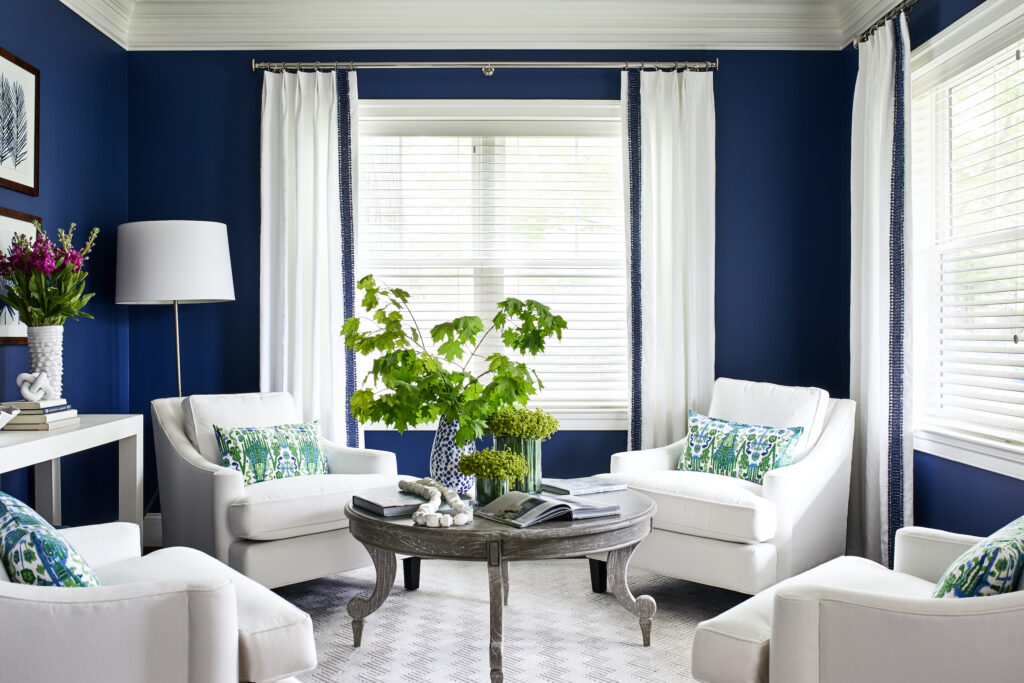
Design by GreyHunt Interiors, Photography by Stacy Zarin Goldberg
The living room is one of the largest (and often one of the most heavily furnished) rooms in a home, making it one of the most expensive to design. A living room budget can vary significantly based on the size of the space. When selecting furniture for the living room, we advise our clients to invest in the sofa & rug. These are the largest & most used pieces in the room and set the tone and overall style of the space. We suggest that our clients select these items carefully, as they’ll likely be in the home for many years to come. Spending more on the sofa & rug will create a higher-end finished product as well. If you’re looking to save money in the living room, we suggest limiting the amount décor and accent furniture to help save your budget for fewer, better pieces.
The Living Room Budget:

The Dining Room:
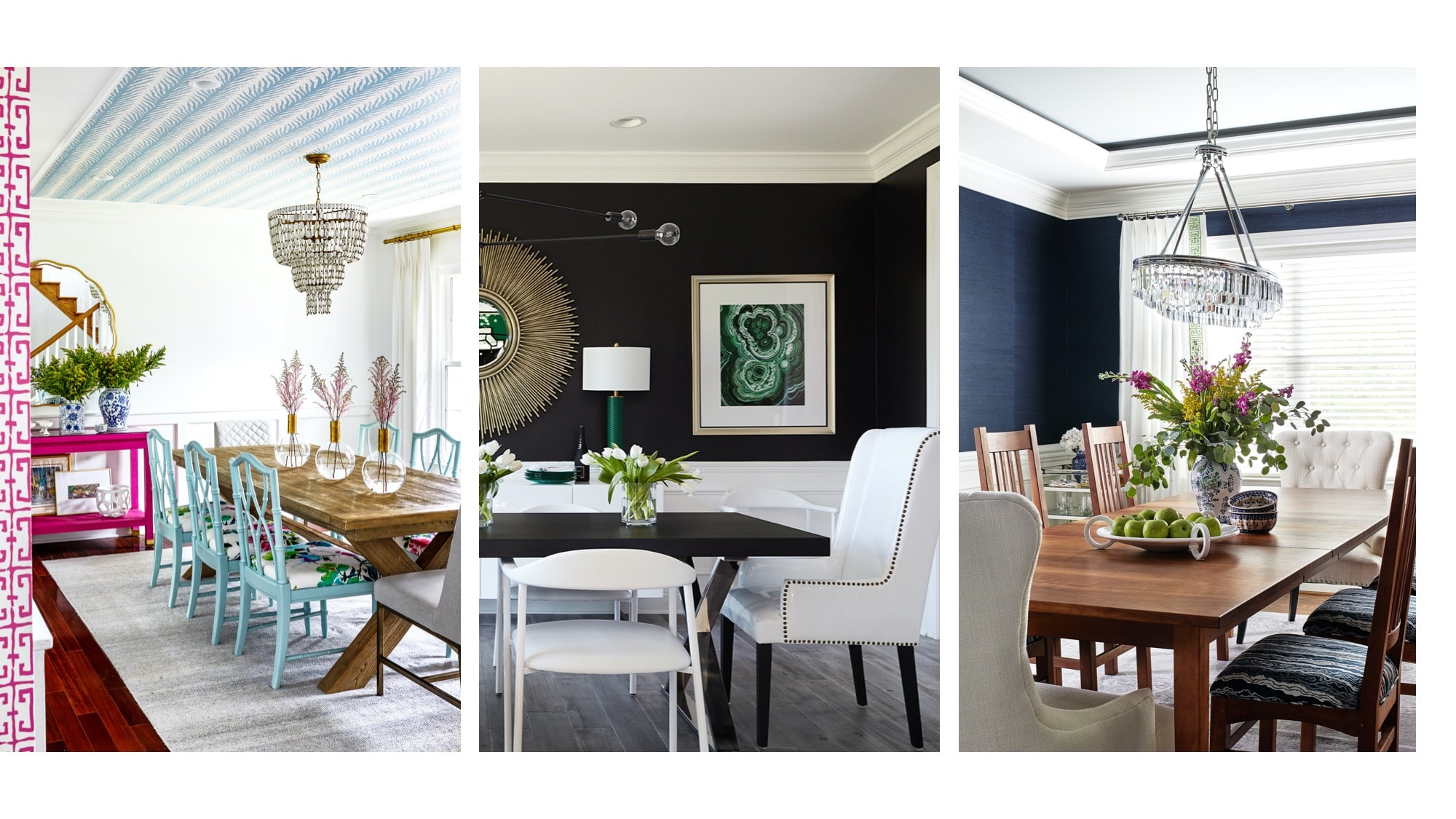
Design by GreyHunt Interiors, Photography by Stacy Zarin Goldberg
The dining room is another space where the budget can vary based on a few factors. When budgeting for a dining room, it’s important to consider: the size of the space, the number of people you want to seat, and how you plan to entertain. When we design dining rooms, we advise our clients to invest most of their budget in the table & chairs. These pieces set the tone and scale of the space and will be pieces they keep for years to come. We also advise our clients to consider splurging on the rug, art, and chandelier, if possible. These pieces will bring the “wow factor” to the dining room. Are you looking to save money? Reduce the number of accent pieces (such as china cabinets, bar carts, etc.) to allocate more money towards the main furnishings.
The Dining Room Budget:
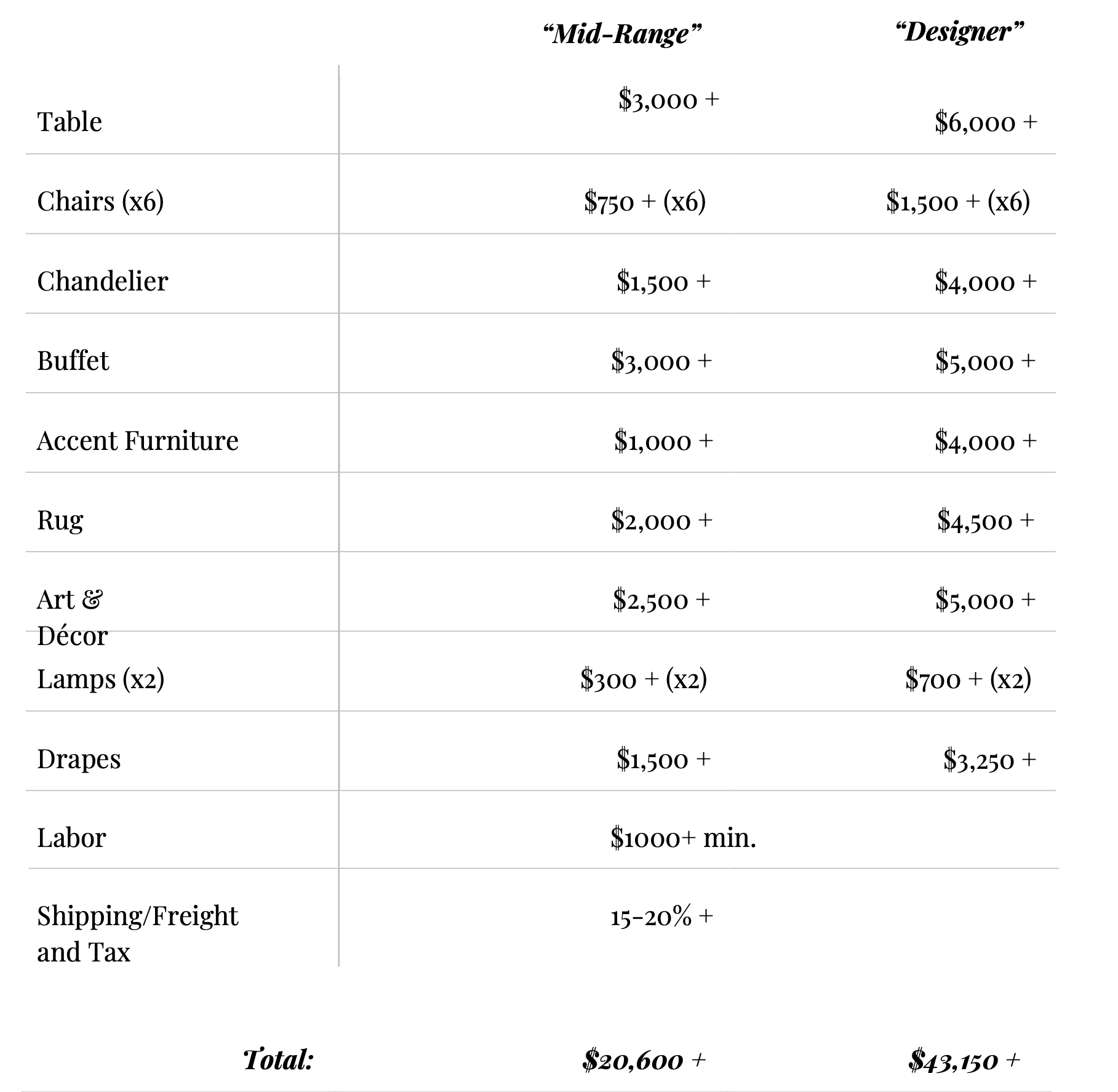
The Bedroom:
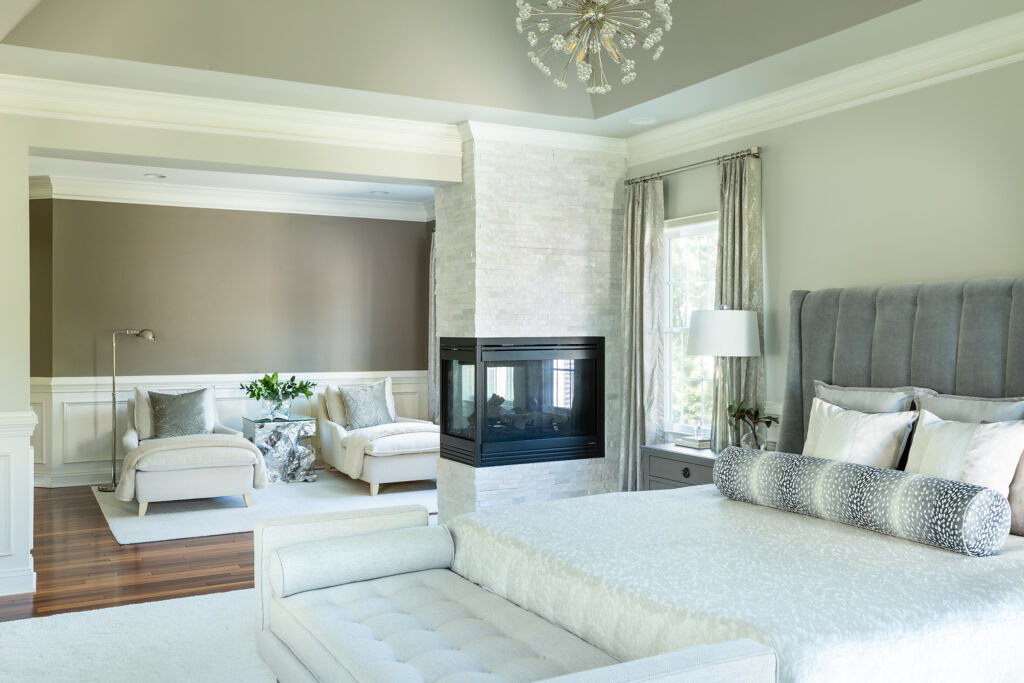
Design by GreyHunt Interiors, Photography by Christy Kosnic
Your bedroom is your sanctuary, so it’s no place to skimp on spending. We suggest that our clients invest the majority of their budget on their bed. The bed frame & headboard are a lifelong investment, and they’ll be in the room for years. We advise our clients to think about how much furniture they’d like to have in the space. Are they looking for just a dresser and nightstands? Or would they also want seating such as a bench, lounge chair & more? The budget will need to be increased to accommodate any of these additional furniture pieces. If you’re looking to save money, go for lower-priced items that you’re more likely to change over time (such as your nightstands, lighting, and accent décor). If you’re tightening your belt, you can usually find high-end-looking bedding at mid-range retailers. Especially if you’re looking for minimal & simple duvet covers, sheets, and quilts – these stores have great options for all of that.
The Bedroom Budget:
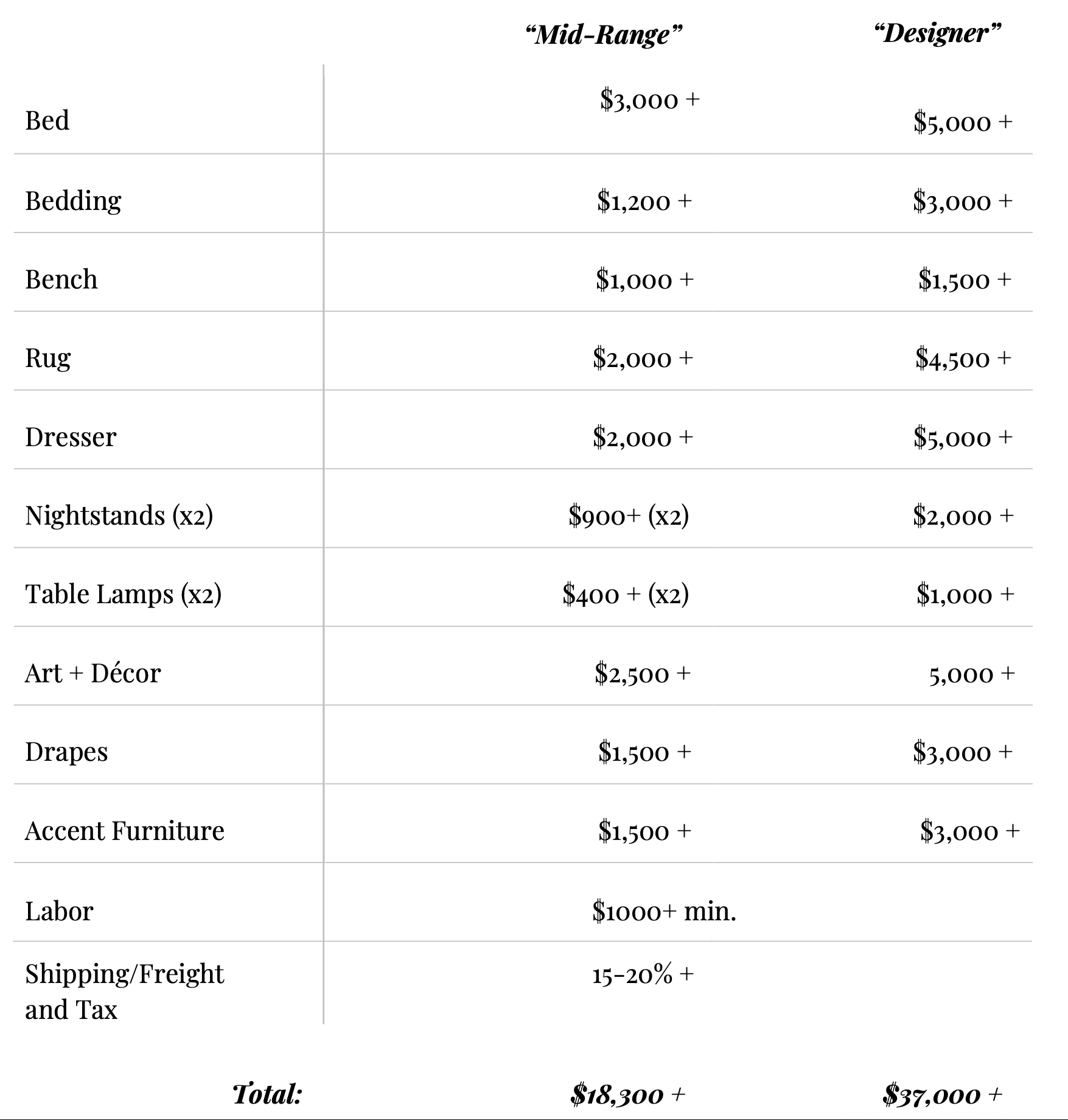
A Disclaimer:
As we stated above, when establishing a budget for your next interior design project, you have many variables to consider. Think about the size of the space, the amount of furniture needed, and the quality of brands you require. And remember, no budget and no project are exactly alike!
We also recommend adding about 18-20% freight to this initial estimate to account for potential overages & upgrades. As mentioned above, maintaining our client's bottom line is of the utmost importance, and we are always on the lookout for amazing deals. However, we would like you to be prepared for potential overages and added costs. Additionally, we ask that you note that the numbers we've proposed are just general estimates to serve as a starting point and a guide. These budgets and prices are not guaranteed nor required. Often our clients select various items from each category to create a project that works for their budget. Not sure about your budget? Download our personalized budget worksheet here to help define it.
Search Posts
Recent Posts
- GreyHunt Interiors Takes The Design World By Storm In 2024
- Hiring A Designer: Why Should You Do It?
- Taking The Old & Making It New Again
- Transform Your Bathroom: Renovation Inspiration
- My Kitchen Renovation Journey: What I Learned as a Designer Renovating My Own Home
- Summer Styling Tips From Sallie Lord of GreyHunt Interiors
- GreyHunt’s New Indiana Home Anniversary
- Designing the GreyHunt Interiors Show Room for the 2024 Decorators’ Show House
- Indy’s Interior Icons: A Peek Inside the Circle City’s Coolest Spaces
- Hidden Gems of Indianapolis: A Staycation To Remember At Bottleworks Hotel
Latest On Instagram
Contact Our Team
Establishing your budget is the first and often one of the most challenging steps in the design process, but you must set a budget to avoid unmet expectations and miscommunication. A budget communicates clearly with your designer about your expectations for furniture quality & design and what you’re willing to pay for both.
Budgeting can be a confusing step for homeowners and clients due to their uncertainty about what a reasonable price is to get their space “looking and feeling” the way they want it to. To help communicate with homeowners about what it can cost to decorate a room, we created this blog post. This post is chock-full of our best tips & tricks for budgeting for your next interior design project, along with a few ways that you can save money.

Design by GreyHunt Interiors, Photography by Stacy Zarin Goldberg and Christy Kosnic
A Good Rule Of Thumb
First, we want to start with some disclaimers (so that everyone is on the same page).
Every project is different, and so is every budget.
There’s no “one-size-fits-all” budget for designing a room. Budgets rely on critical information such as the size of the room, the quality & brands of furniture required, and the specific pieces/amount of furniture you’ll need to purchase. Budgets also don’t always fall into the two categories we’ve laid out below. Often, our clients select various pieces from each price category to create their customized budget. For example, a client may choose a trade brand sofa but decide to save money with retail-level chairs. Mixing & matching pieces in a design to meet your budget is one of the many things a professional interior designer does for you. **To help create your estimated budget, download our personalized budget worksheet here.
Budget with your home’s value in-mind.
What you should spend on a home renovation or just furnishings depends on the overall value of your home. As a general rule of thumb, we suggest allocating about 7-10% of the home's value for interior design expenses. This will give you a design with some "Mid-Range" products. If you're looking for "Designer" level finishes, we recommend budgeting about 25% of the home's overall value. For example, for a $2 Million home, we would suggest budgeting around $500,000+ to decorate & design the whole house at the "Designer" level. * It's important to note that these prices would not include home renovation expenses (construction costs, etc.) Feeling like that's a lot of money? We understand! Keep in mind that many clients have items that we can work with (ex. re-upholstering, re-finishing, or using pieces as-is) which can help save money & reduce expenses.) Don't worry - we will always keep your bottom line in mind and are constantly looking for the best available deals.
Plan to go over-budget:
I know this sounds counter-intuitive, but it’s not. With our years of experience, we’ve learned that people (on average) tend to go over their budget. This doesn’t mean that you won’t be able to stick to a budget. It just means that client’s often add features or upgrade finishes as the design process progresses—all of these additions, in turn, increase the scope and cost of the budget. To avoid unexpected overages (or disappointed expectations), we suggest that our clients add about 20% to their initial budget estimate. This will leave wiggle room for upgrades and allow for more accurate financial expectations. For example, for a $2 million home, if a client budgets $500,000 and adds 20%, they’ll end up with an estimated budget of $600K. Now they’ve got plenty of wiggle room within the budget for any changes or upgrades.
A Designer's Budget:
Interior designers are, in fact, professionals, but of course, you already knew that. We only say this because homeowners often fail to realize the benefits of hiring a professional (and yes, these benefits can include saving you money.) Need to know more about the benefits of hiring an interior designer? Read our blog post “Hiring an Interior Designer- Why You Should Do It.” We’re just going to discuss how hiring an Interior Designer can impact the budget for this post.
First, Interior Designers have access to exclusive furnishings and finishes, called “Trade Brands.” These higher-end furnishings, fabrics, lighting, and décor are only available to interior designers and people who work within the “trade” (hence the name). These products are often of superior quality and design and are typically offered at wholesale pricing to designers (meaning you can save money vs. shopping independently).
Second, Interior Designers use their design expertise & experience to “value engineer” your project. Now, what does that mean? “Value Engineering” means that a designer looks at the overall scope of your project and then decides where to splurge vs. where to save while still achieving the same general aesthetic & design quality. This may sound easy, but trust us…it’s not.
Third, and this one may seem unnecessary to say, but interior designers do work hard to stay within your budget. As long as you have clear communication and realistic expectations, a designer will always work to stay within your budget. We may sometimes suggest more expensive upgrades or features, but that’s only to make our clients aware of all of their options. Sometimes clients choose to increase their budget after discovering what would be possible if they spent just a bit more money.
Price Categories:
Now, to get down to the brass tacks of why you’re here: What will this cost you? As we said earlier, every project (& therefore every budget) is different. So, to simplify this complicated topic, we created two categories for the various price-points of furniture.
Mid-Range:
The first category is called “Mid-Range,” and it’s oriented around moderately priced retail brands, such as West Elm, Crate & Barrel, Pottery Barn, Restoration Hardware, Arhaus, and more. This category is great for clients looking for better quality but not looking to make life-long investments in furnishings. These furnishings can be fashionable but often trend towards more practical designs (to appeal to the widest audience). We suggest that clients use this category as a budget-saving alternative for smaller pieces, such as side tables, ottomans, and occasional chairs. Pieces that aren’t heavily used and won’t endure lots of wear are great from this category.
Designer:
The second and final category is called “Designer.” This category comprises mainly trade brands such as Sunpan, Arteriors, Made Goods, World’s Away, and more. Though you’ve likely never heard of these brands, designers are very familiar with the quality & style that they offer exclusively to the trade community. These products will be of the highest quality and often include semi-custom and custom design options. Furniture from this category will be a life-long investment and can later be reupholstered for an updated look. We, of course, recommend that our clients plan for the majority of their furniture & décor to come from this category, but we do understand that budgets can require lower-cost alternatives. Therefore, we go to Market every season to preview the exclusive new products from these trade brands. This way, we can offer our clients the latest and greatest of what’s available.
Budgeting By Room:
To help you better understand the costs associated with each of these categories, we’ve created price charts for three different room design scenarios. First, we created a chart for budgeting a living room, a dining room, and a bedroom. These are the three most common spaces clients ask for help with, and they tend to be some of the most heavily furnished rooms (so they’ll give you a good idea of what an entire budget will look like).
The Living Room:

Design by GreyHunt Interiors, Photography by Stacy Zarin Goldberg
The living room is one of the largest (and often one of the most heavily furnished) rooms in a home, making it one of the most expensive to design. A living room budget can vary significantly based on the size of the space. When selecting furniture for the living room, we advise our clients to invest in the sofa & rug. These are the largest & most used pieces in the room and set the tone and overall style of the space. We suggest that our clients select these items carefully, as they’ll likely be in the home for many years to come. Spending more on the sofa & rug will create a higher-end finished product as well. If you’re looking to save money in the living room, we suggest limiting the amount décor and accent furniture to help save your budget for fewer, better pieces.
The Living Room Budget:

The Dining Room:

Design by GreyHunt Interiors, Photography by Stacy Zarin Goldberg
The dining room is another space where the budget can vary based on a few factors. When budgeting for a dining room, it’s important to consider: the size of the space, the number of people you want to seat, and how you plan to entertain. When we design dining rooms, we advise our clients to invest most of their budget in the table & chairs. These pieces set the tone and scale of the space and will be pieces they keep for years to come. We also advise our clients to consider splurging on the rug, art, and chandelier, if possible. These pieces will bring the “wow factor” to the dining room. Are you looking to save money? Reduce the number of accent pieces (such as china cabinets, bar carts, etc.) to allocate more money towards the main furnishings.
The Dining Room Budget:

The Bedroom:

Design by GreyHunt Interiors, Photography by Christy Kosnic
Your bedroom is your sanctuary, so it’s no place to skimp on spending. We suggest that our clients invest the majority of their budget on their bed. The bed frame & headboard are a lifelong investment, and they’ll be in the room for years. We advise our clients to think about how much furniture they’d like to have in the space. Are they looking for just a dresser and nightstands? Or would they also want seating such as a bench, lounge chair & more? The budget will need to be increased to accommodate any of these additional furniture pieces. If you’re looking to save money, go for lower-priced items that you’re more likely to change over time (such as your nightstands, lighting, and accent décor). If you’re tightening your belt, you can usually find high-end-looking bedding at mid-range retailers. Especially if you’re looking for minimal & simple duvet covers, sheets, and quilts – these stores have great options for all of that.
The Bedroom Budget:

A Disclaimer:
As we stated above, when establishing a budget for your next interior design project, you have many variables to consider. Think about the size of the space, the amount of furniture needed, and the quality of brands you require. And remember, no budget and no project are exactly alike!
We also recommend adding about 18-20% freight to this initial estimate to account for potential overages & upgrades. As mentioned above, maintaining our client's bottom line is of the utmost importance, and we are always on the lookout for amazing deals. However, we would like you to be prepared for potential overages and added costs. Additionally, we ask that you note that the numbers we've proposed are just general estimates to serve as a starting point and a guide. These budgets and prices are not guaranteed nor required. Often our clients select various items from each category to create a project that works for their budget. Not sure about your budget? Download our personalized budget worksheet here to help define it.
Search Posts
Recent Posts
- GreyHunt Interiors Takes The Design World By Storm In 2024
- Hiring A Designer: Why Should You Do It?
- Taking The Old & Making It New Again
- Transform Your Bathroom: Renovation Inspiration
- My Kitchen Renovation Journey: What I Learned as a Designer Renovating My Own Home
- Summer Styling Tips From Sallie Lord of GreyHunt Interiors
- GreyHunt’s New Indiana Home Anniversary
- Designing the GreyHunt Interiors Show Room for the 2024 Decorators’ Show House
- Indy’s Interior Icons: A Peek Inside the Circle City’s Coolest Spaces
- Hidden Gems of Indianapolis: A Staycation To Remember At Bottleworks Hotel



